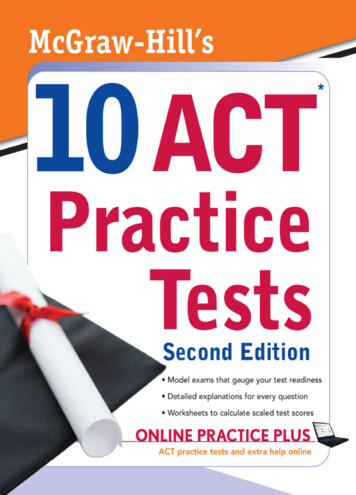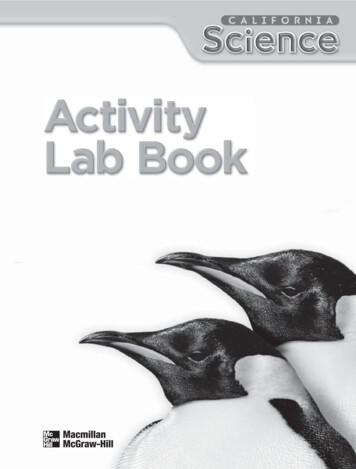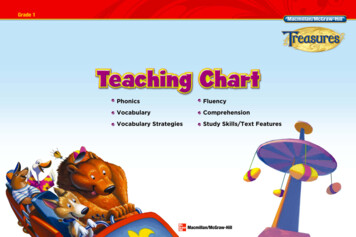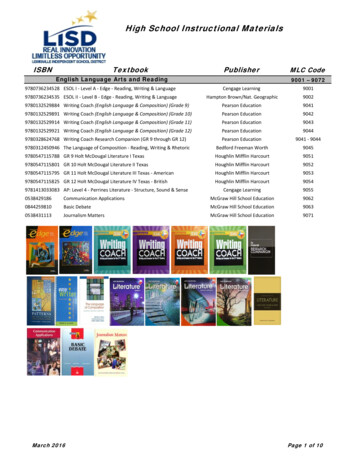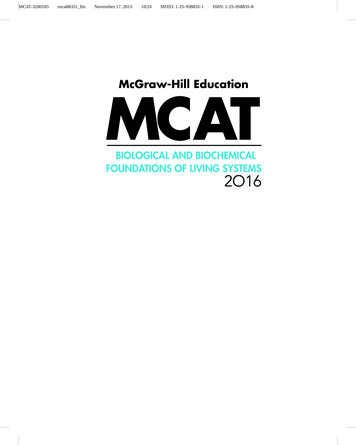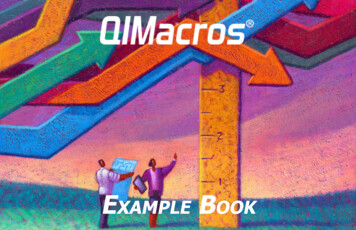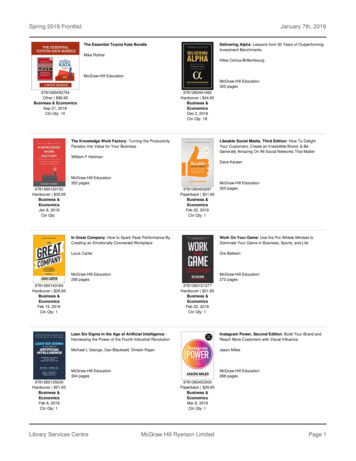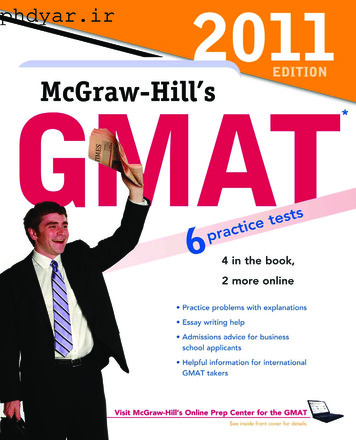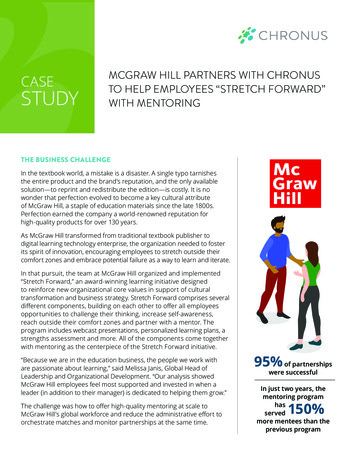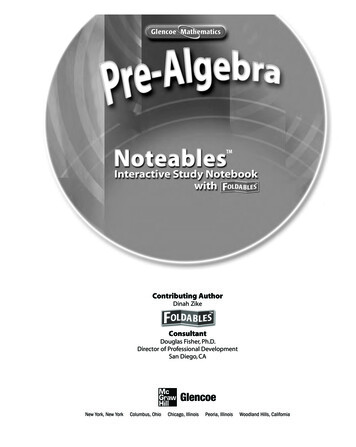
Transcription
Contributing AuthorDinah ZikeConsultantDouglas Fisher, Ph.D.Director of Professional DevelopmentSan Diego, CANational FM-877210.indd i6/9/06 4:07:31 PM
Copyright by The McGraw-Hill Companies, Inc. All rights reserved. Printed in theUnited States of America. Except as permitted under the United States Copyright Act,no part of this book may be reproduced in any form, electronic or mechanical, includingphotocopy, recording, or any information storage or retrieval system, without priorwritten permission of the publisher.Send all inquiries to:The McGraw-Hill Companies8787 Orion PlaceColumbus, OH 43240-4027ISBN-13: 978-07-877210-8ISBN-10: 0-07-877210-9Pre-Algebra (Student Edition)Noteables : Interactive Study Notebook with Foldables 1 2 3 4 5 6 7 8 9 10 047 11 10 09 08 07 06National FM-877210.indd ii6/7/06 1:12:45 PM
ContentsCopyright Glencoe/McGraw-Hill, a division of The McGraw-Hill Companies, Inc.Foldables. . . . . . . . . . . . . . . . . . . . . . . . . . . 1Vocabulary Builder . . . . . . . . . . . . . . . . . . . 21-1 Using a Problem-Solving Plan . . . . . 41-2 Numbers and Expressions . . . . . . . . 71-3 Variables and Expressions . . . . . . . 101-4 Properties . . . . . . . . . . . . . . . . . . . . 141-5 Variables and Equations . . . . . . . . 161-6 Ordered Pairs and Relations . . . . . 191-7 Scatter Plots . . . . . . . . . . . . . . . . . . 23Study Guide . . . . . . . . . . . . . . . . . . . . . . . 27Foldables. . . . . . . . . . . . . . . . . . . . . . . . . .Vocabulary Builder . . . . . . . . . . . . . . . . . .2-1 Integers and Absolute Value . . . . .2-2 Adding Integers . . . . . . . . . . . . . . .2-3 Subtracting Integers . . . . . . . . . . . .2-4 Multiplying Integers . . . . . . . . . . . .2-5 Dividing Integers . . . . . . . . . . . . . .2-6 The Coordinate System . . . . . . . . .Study Guide . . . . . . . . . . . . . . . . . . . . . . .313234374143454750Foldables. . . . . . . . . . . . . . . . . . . . . . . . . .Vocabulary Builder . . . . . . . . . . . . . . . . . .3-1 The Distributive Property . . . . . . . .3-2 Simplifying Algebraic Expressions .3-3 Solving Equations by Addingor Subtracting . . . . . . . . . . . . . . . . .3-4 Solving Equations by Multiplyingor Dividing . . . . . . . . . . . . . . . . . . .3-5 Solving Two-Step Equations . . . . .3-6 Writing Two-Step Equations . . . . .3-7 Sequences and Equations . . . . . . .3-8 Using Formulas . . . . . . . . . . . . . . . .Study Guide . . . . . . . . . . . . . . . . . . . . . . .53545659Foldables. . . . . . . . . . . . . . . . . . . . . . . . . .Vocabulary Builder . . . . . . . . . . . . . . . . . .4-1 Powers and Exponents . . . . . . . . . .4-2 Prime Factorization . . . . . . . . . . . .4-3 Greatest Common Factor . . . . . . . .8182848789626567707274774-44-5Simplifying Algebraic Fractions . . .Multiplying and DividingMonomials . . . . . . . . . . . . . . . . . . .4-6 Negative Exponents . . . . . . . . . . . .4-7 Scientific Notation . . . . . . . . . . . . .Study Guide . . . . . . . . . . . . . . . . . . . . . . .Foldables. . . . . . . . . . . . . . . . . . . . . . . . .Vocabulary Builder . . . . . . . . . . . . . . . . .5-1 Writing Fractions as Decimals . . .5-2 Rational Numbers . . . . . . . . . . . . .5-3 Multiplying Rational Numbers . .5-4 Dividing Rational Numbers . . . . .5-5 Adding and Subtracting LikeFractions . . . . . . . . . . . . . . . . . . . .5-6 Least Common Multiple . . . . . . . .5-7 Adding and Subtracting UnlikeFractions . . . . . . . . . . . . . . . . . . . .5-8 Solving Equations with RationalNumbers . . . . . . . . . . . . . . . . . . . .5-9 Measures of Central Tendency . .Study Guide . . . . . . . . . . . . . . . . . . . . . bles. . . . . . . . . . . . . . . . . . . . . . . . . 133Vocabulary Builder . . . . . . . . . . . . . . . . . 1346-1 Ratios and Rates . . . . . . . . . . . . . . 1366-2 Proportional and NonproportionalRelationships. . . . . . . . . . . . . . . . . 1386-3 Using Proportions . . . . . . . . . . . . . 1406-4 Scale Drawings and Models . . . . . 1426-5 Fractions, Decimals, and Percents 1456-6 Using the Percent Proportion . . . 1486-7 Finding Percents Mentally . . . . . . 1516-8 Using Percent Equations . . . . . . . 1536-9 Percent of Change . . . . . . . . . . . . 1566-10 Using Sampling to Predict . . . . . . 158Study Guide . . . . . . . . . . . . . . . . . . . . . . 161Foldables. . . . . . . . . . . . . . . . . . . . . . . . .Vocabulary Builder . . . . . . . . . . . . . . . . .7-1 Functions . . . . . . . . . . . . . . . . . . . .7-2 Representing Linear Functions . .Glencoe Pre-AlgebraNational FM-877210.indd iii91165166168170iii6/7/06 1:12:45 PM
Contents7-37-4Rate of Change . . . . . . . . . . . . . . .Constant Rate of Change andDirect Variation . . . . . . . . . . . . . .7-5 Slope . . . . . . . . . . . . . . . . . . . . . . .7-6 Slope-Intercept Form . . . . . . . . . .7-7 Writing Linear Equations . . . . . . .7-8 Prediction Equations . . . . . . . . . .Study Guide . . . . . . . . . . . . . . . . . . . . . .Foldables. . . . . . . . . . . . . . . . . . . . . . . . .Vocabulary Builder . . . . . . . . . . . . . . . . .8-1 Solving Equations with Variableson Each Side . . . . . . . . . . . . . . . . .8-2 Solving Equations with GroupingSymbols . . . . . . . . . . . . . . . . . . . . .8-3 Inequalities . . . . . . . . . . . . . . . . . .8-4 Solving Inequalities by Addingor Subtracting . . . . . . . . . . . . . . . .8-5 Solving Inequalities byMultiplying or Dividing . . . . . . . .8-6 Solving Multi-Step Inequalities . .Study Guide . . . . . . . . . . . . . . . . . . . . . .Foldables. . . . . . . . . . . . . . . . . . . . . . . . .Vocabulary Builder . . . . . . . . . . . . . . . . .10-1 Line and Angle Relationships . . .10-2 Congruent Triangles . . . . . . . . . . .10-3 Transformations in theCoordinate Plane . . . . . . . . . . . . .10-4 Quadrilaterals . . . . . . . . . . . . . . . .10-5 Polygons . . . . . . . . . . . . . . . . . . . .10-6 Area: Parallelograms, Triangles,and Trapezoids . . . . . . . . . . . . . . .ivNational FM-877210.indd iv17617918218418819119519619719920110-7 Circles: Circumference and Area . 25410-8 Area: Composite Figures . . . . . . . 257Study Guide . . . . . . . . . . . . . . . . . . . . . . 259Foldables. . . . . . . . . . . . . . . . . . . . . . . . .Vocabulary Builder . . . . . . . . . . . . . . . . .11-1 Three-Dimensional Figures . . . . .11-2 Volume: Prisms and Cylinders . . .11-3 Volume: Pyramids, Cones, andSpheres . . . . . . . . . . . . . . . . . . . . .11-4 Surface Area: Prisms andCylinders . . . . . . . . . . . . . . . . . . . .11-5 Surface Area: Pyramids andCones . . . . . . . . . . . . . . . . . . . . . . .11-6 Similar Solids . . . . . . . . . . . . . . . . .Study Guide . . . . . . . . . . . . . . . . . . . . . .263264266269Foldables. . . . . . . . . . . . . . . . . . . . . . . . .Vocabulary Builder . . . . . . . . . . . . . . . . .12-1 Stem-and-Leaf Plots . . . . . . . . . . .12-2 Measures of Variation . . . . . . . . .12-3 Box-and-Whisker Plots . . . . . . . . .12-4 Histograms . . . . . . . . . . . . . . . . . .12-5 Selecting an Appropriate Display12-6 Misleading Graphs . . . . . . . . . . . .12-7 Simple Probability . . . . . . . . . . . .12-8 Counting Outcomes . . . . . . . . . . .12-9 Permutations and Combinations .12-10 Probability of Composite EventsStudy Guide . . . . . . . . . . . . . . . . . . . . . .287288290294298301305307309311314317320Foldables. . . . . . . . . . . . . . . . . . . . . . . . .Vocabulary Builder . . . . . . . . . . . . . . . . .13-1 Polynomials . . . . . . . . . . . . . . . . . .13-2 Adding Polynomials . . . . . . . . . . .13-3 Subtracting Polynomials . . . . . . .13-4 Multiplying a Polynomial bya Monomial. . . . . . . . . . . . . . . . . .13-5 Linear and Nonlinear Functions .13-6 Graphing Quadratic and CubicFunctions . . . . . . . . . . . . . . . . . . . .Study Guide . . . . . . . . . . . . . . . . . . . . . yright Glencoe/McGraw-Hill, a division of The McGraw-Hill Companies, Inc.Foldables. . . . . . . . . . . . . . . . . . . . . . . . .Vocabulary Builder . . . . . . . . . . . . . . . . .9-1 Squares and Square Roots . . . . . .9-2 The Real Number System . . . . . . .9-3 Triangles . . . . . . . . . . . . . . . . . . . .9-4 The Pythagorean Theorem . . . . .9-5 The Distance Formula. . . . . . . . . .9-6 Similar Figures and IndirectMeasurement . . . . . . . . . . . . . . . .Study Guide . . . . . . . . . . . . . . . . . . . . . .173339342251Glencoe Pre-Algebra6/7/06 1:12:47 PM
Organizing Your FoldablesMake this Foldable to help you organize andstore your chapter Foldables. Begin with onesheet of 11" 17" paper.FoldFold the paper in half lengthwise. Then unfold.Copyright Glencoe/McGraw-Hill, a division of The McGraw-Hill Companies, Inc.Fold and GlueFold the paper in half widthwise and glue all of the edges.Glue and LabelGlue the left, right, and bottom edges of the Foldableto the inside back cover of your Noteables notebook.Foldables OrganizerReading and Taking Notes As you read and study each chapter, recordnotes in your chapter Foldable. Then store your chapter Foldables insidethis Foldable organizer.Glencoe Pre-AlgebraNational FM-877210.indd vv6/7/06 1:12:48 PM
This note-taking guide is designed to help you succeed inPre-Algebra. Each chapter includes:CHAPTER3EquationsUse the instructions below to make a Foldable to help youorganize your notes as you study the chapter. You will seeFoldable reminders in the margin of this Interactive StudyNotebook to help you in taking notes.The Chapter Openercontains instructions andillustrations on how to makea Foldable that will help youto organize your notes.1" 11" paper.Begin with five sheets of 82Stack 5 sheets of3paperinch apart.4Label the tabs withtopics from the chapter.Chapter 3Crease and staplealong fold.CH «ÌiÀÊÎµÕ Ì ÃiÀÌÞÇ Ê-iµÕi ViÃÊ Ên Ê À Õ Ã Ê,iÛ iÜµÕ Ì ÃBUILD YOUR VOCABULARYThis is an alphabetical list of new vocabulary terms you will learn in Chapter 3.As you complete the study notes for the chapter, you will see Build YourVocabulary reminders to complete each term’s definition or description onthese pages. Remember to add the textbook page number in the secondcolumn for reference when you study.NOTE-TAKING TIP: When you take notes, includedefinitions of new terms, explanations of newconcepts, and examples of problems.A Note-Taking Tipprovides a helpfulhint you can usewhen taking notes.APTER3 Ê ÃÌÀ LÕÌ ÛiÊ*À « ÃÝ«ÀiÃÃ Ó Ê- « vÞ }Ê Î Ê µÕ Ì Ã\Ê { Ê µÕ Ì Ã\ÊX µÕ Ì Ãx Ê/Ü -Ìi«ÊµÕ Ì ÃÈ Ê7À Ì }ÊGlencoe Pre-Algebra0053-0080 CH03 875692 .indd 1Vocabulary Term53Foundon PageDefinitionDescription orExamplearea5/26/06 11:09:12 AMcoefficient[koh-uh-FIHSH-ehnt]The Build Your Vocabularytable allows you to writedefinitions and examplesof important vocabularyterms together in oneconvenient place.equivalent equationsequivalent expressionsformula54Glencoe Pre-Algebra0053-0080 CH03 875692 .indd 2viNational FM-877210.indd viWithin each chapter,Build Your Vocabularyboxes will remind youto fill in this table.Copyright Glencoe/McGraw-Hill, a division of The McGraw-Hill Companies, Inc.constantCopyright Glencoe/McGraw-Hill, a division of The McGraw-Hill Companies, Inc.Copyright Glencoe/McGraw-Hill, a division of The McGraw-Hill Companies, Inc.Roll up the bottomedges. All tabs shouldbe the same size.5/26/06 11:09:14 AMGlencoe Pre-Algebra6/7/06 1:12:49 PM
Lessons cover the content ofthe lessons in your textbook.As your teacher discusses eachexample, follow along andcomplete the fill-in boxes.Take notes as appropriate.Solving Two-Step Equations3–5BUILD YOUR VOCABULARY (page 55)MAIN IDEAA two-step equation contains Solve two-stepoperations.equations.EXAMPLESolve Two-Step Equationsa. Solve 3x - 4 17.3x - 4 17 Add Simplify.3x21 Under Two-StepEquations tab, write atwo-step equation. Thenwrite the order of thesteps you would use tosolve that equation. Copyright Glencoe/McGraw-Hill, a division of The McGraw-Hill Companies, Inc.ORGANIZE IT «ÌiÀÊÎµÕ Ì Ãto each side.Undo.Divide each side by.Examples parallel theexamples in your textbook.Simplify.nb. 3 8iÀÌÞ Ê ÃÌÀ LÕÌ ÛiÊ*À « ÃÝ«ÀiÃÃ Ó Ê- « vÞ }Ê Î Ê µÕ Ì Ã\Ê { Ê µÕ Ì Ã\ÊX µÕ Ì Ãx Ê/Ü -Ìi«ÊµÕ Ì ÃÈ Ê7À Ì }Ê3n Ê À Õ Ã Ê,iÛ iÜ3–6n 8-3-µÕ Ì ÃÇ Ê-iµÕi ViÃÊ ÊSubtract3n-5 from each side.EXAMPLEEARNINGS Ms. Parsons earns 48,400 per year. This is 4150 more than three times as much as her daughterearns. How much does her daughter earn?Simplify.3n(-5) 3( )Multiply each side by n.WordsSimplify.Check Your Progress Solve each equation.a. 4x 3 19b.Write and Solve a Two-Step Equationw- 8 -46Ms. Parsons earns 4150 more than threetimes as much as her daughter.VariableLet d daughter’s earningsEquationthree times asmoremuch asMs. Parsons earns 4150 than her daughter 4150 Glencoe Pre-AlgebraCHBRINGING IT ALL TOGETHERSTUDY GUIDEUse your Chapter 3 Foldableto help you study for yourchapter test.VOCABULARYPUZZLEMAKERBUILD YOURVOCABULARYTo make a crossword puzzle,word search, or jumble puzzleof the vocabulary words inChapter 3, go to:You can use your completedVocabulary Builder(pages 54–55) to help yousolve the puzzle.- Simplify. Divide each side by Simplify.Check Your Progress SHOPPING Tami spent 175 at thegrocery store. That is 25 less than four times as much as Tedspent. How much did Ted spend?HOMEWORKASSIGNMENTPage(s):Exercises:Check Your Progress Exercisesallow you to solve similarexercises on your own. 71Glencoe Pre-AlgebraMatch each expression with an equivalent expression.1. 5(4 7) 4150 Ms. Parsons’ daughter earns3-1The Distributive Propertya. 5 · 7 4 · 7b. (-4) · 5 (-4) · (-7)0053-0080 CH03 875692 .indd 195/26/06 11:09:52 AMc. 5 · 4 5 · 73. -4(5 7)4. (5 - 7)4d. (-4) · 5 (-4) · 7e. -5 · 7 (-5) · 4f. 5 · 4 (-7) · 45. -4(5 - 7)6. In rewriting 3(x 2), which term is “distributed” to the otherterms in the expression?Bringing It All TogetherStudy Guide reviewsthe main ideas and keyconcepts from each lesson.3-2Simplifying Algebraic ExpressionsUnderline the term that best completes each statement.7. A term without a variable is a (coefficient, constant).8. The expression 5z 2z 9 6z has three (like terms, terms).Simplify each expression.9. 6q 2q11. 5 7x - 310. 12y - y12. 4(b 1) bGlencoe Pre-Algebra0053-0080 CH03 875692 .indd 25National FM-877210.indd vii-glencoe.com2. (5 4)7Write the equation.from each side.Subtract5/26/06 11:09:43 AMAPTER3Copyright Glencoe/McGraw-Hill, a division of The McGraw-Hill Companies, Inc.Copyright Glencoe/McGraw-Hill, a division of The McGraw-Hill Companies, Inc.0053-0080 CH03 875692 .indd 1567Copyright Glencoe/McGraw-Hill, a division of The McGraw-Hill Companies, Inc.Foldables featurereminds you to takenotes in your Foldable. 4150775/26/06 11:10:07 AMGlencoe Pre-Algebravii6/7/06 1:12:51 PM
NOTE-TAKING TIPSYour notes are a reminder of what you learned in class. Taking good notescan help you succeed in mathematics. The following tips will help you takebetter classroom notes. Before class, ask what your teacher will be discussing in class. Reviewmentally what you already know about the concept. Be an active listener. Focus on what your teacher is saying. Listen forimportant concepts. Pay attention to words, examples, and/or diagramsyour teacher emphasizes. Write your notes as clear and concise as possible. The following symbolsand abbreviations may be helpful in your note-taking.Word or PhraseSymbol orAbbreviationWord or PhraseSymbol orAbbreviationfor examplee.g.not equal such asi.e.approximately withw/therefore withoutw/oversusvsand angle Ask questions and participate in class discussion. Draw and label pictures or diagrams to help clarify a concept. When working out an example, write what you are doing to solve theproblem next to each step. Be sure to use your own words. Review your notes as soon as possible after class. During this time, organizeand summarize new concepts and clarify misunderstandings.Note-Taking Don’ts Don’t write every word. Concentrate on the main ideas and concepts. Don’t use someone else’s notes as they may not make sense. Don’t doodle. It distracts you from listening actively. Don’t lose focus or you will become lost in your note-taking.viiiNational FM-877210.indd viiiCopyright Glencoe/McGraw-Hill, a division of The McGraw-Hill Companies, Inc. Use a symbol such as a star ( ) or an asterisk (*) to emphasize importantconcepts. Place a question mark (?) next to anything that you do notunderstand.Glencoe Pre-Algebra6/7/06 1:12:56 PM
APTER1Chapter 1CHThe Tools of AlgebraUse the instructions below to make a Foldable to help youorganize your notes as you study the chapter. You will seeFoldable reminders in the margin of this Interactive StudyNotebook to help you in taking notes.Begin with a sheet of unlined paper.Fold the short sides so theymeet in the middle.Copyright Glencoe/McGraw-Hill, a division of The McGraw-Hill Companies, Inc.Fold the top tothe bottom.Unfold. Cut along thesecond fold to makefour tabs.Label each of the tabsas shown.&XPLORE1LAN HECK4OLVENOTE-TAKING TIP: When you take notes, be sureto describe steps in detail. Include examples ofquestions you might ask yourself during problemsolving.Glencoe Pre-Algebra0001-0030 CH01 875692.indd 116/7/06 2:21:03 PM
CHAPTER1BUILD YOUR VOCABULARYThis is an alphabetical list of new vocabulary terms you will learn in Chapter 1.As you complete the study notes for the chapter, you will see Build YourVocabulary reminders to complete each term’s definition or description onthese pages. Remember to add the textbook page number in the secondcolumn for reference when you study.Vocabulary TermFoundon PageDefinitionDescription orExamplealgebraalgebraic oor]counterexampledeductive reasoningdomainequationevaluateCopyright Glencoe/McGraw-Hill, a division of The McGraw-Hill Companies, Inc.coordinate plane orcoordinate systeminductive reasoning[in DUHK-tihv]2Glencoe Pre-Algebra0001-0030 CH01 875692.indd 26/7/06 2:21:05 PM
Chapter 1 BUILD YOUR VOCABULARYVocabulary TermFoundon PageDefinitionDescription orExamplenumerical expressionopen sentenceorder of operationsordered pairCopyright Glencoe/McGraw-Hill, a division of The McGraw-Hill Companies, Inc.propertiesrangerelationscatter plotsimplifysolutionvariableGlencoe Pre-Algebra0001-0030 CH01 875692.indd 336/7/06 2:21:06 PM
1–1Using a Problem-Solving PlanEXAMPLEMAIN IDEAS Use a four-step planto solve problems. Choose an appropriatemethod of computation.Use the Four-Step Problem-Solving PlanPIZZA The price of a large cheese pizza at Paul’s Pizzais 9.25. You receive a 0.50 discount for each additionalpizza ordered, up to 10. So, one pizza costs 9.25, twopizzas cost 8.75 each, three pizzas cost 8.25, and soon. If you need 8 pizzas for a party, what is the costper pizza?EXPLORE The problem gives the cost for the first pizza andthe discount for each additional pizza ordered. Findthe cost per pizza for 8 pizzas.PLANLook for a pattern in the costs. Extend the patternto find the cost per pizza for 8 pizzas.SOLVEFirst, find the pattern.1 pizza:-or3 pizzas:-orNow, extend the pattern.4 pizzas:-or5 pizzas:-or6 pizzas:-or7 pizzas:-or8 pizzas:-orThe cost per pizza for 8 pizzas isREMEMBER ITAlways check tobe sure your answeris reasonable. Ifthe answer seemsunreasonable, solvethe problem again.4CHECK.It costs 9.25 for one pizza with a discount of 0.50for each additional pizza ordered. For an order of8 pizzas, the cost per pizza would be 9.25 - (7 9.25 -Copyright Glencoe/McGraw-Hill, a division of The McGraw-Hill Companies, Inc.2 pizzas:) or .Glencoe Pre-Algebra0001-0030 CH01 875692.indd 46/7/06 2:21:07 PM
1–1Check Your Progress The cost of renting movies at Mike’sMarvelous Movie House is advertised as 5 for the first movieand 3.50 for each additional movie. Find the cost of renting6 movies.ORGANIZE ITWrite this Your TurnExercise under the Checktab of the Foldable. Thenunder the remainingtabs, record how you willexplore, plan, and solveto reach a solution.&XPLORE1LAN HECK4OLVEBUILD YOUR VOCABULARY (page 2)A conjecture is an,guess.When you make a conjecture based on a pattern ofexamples or past events, you are using inductivereasoning.EXAMPLEUse Inductive ReasoningCopyright Glencoe/McGraw-Hill, a division of The McGraw-Hill Companies, Inc.a. Find the next term in 1, 4, 16, 64, 256, . . .1,4,16,64,256 b. Draw the next figure in the pattern.The shaded point on the triangle moves in the pattern: right,top, bottom, left, right, etc. If the pattern continues, the shadedpoint will be at theof the next figure.Check Your Progressa. Find the next term in 48, 43, 38, 33, 28, . . .b. Draw the next figure in the pattern.Glencoe Pre-Algebra0001-0030 CH01 875692.indd 556/7/06 2:21:09 PM
1–1EXAMPLEChoose the Method of ComputationPLANETS The chart shows the distance of selectedplanets from the Sun. About how much farther is it fromEarth to the Sun than from Mercury to the Sun?PlanetDistance from Sun(millions of PLORE You know the distance from Earth to theand the distance fromto the Sun.You need to find about how much farther it is fromto thePLAN.The question uses the word about, so an exactanswer is not needed. We can solve the problem. Estimate each distanceand then.Distance from Earth to the Sun:92.9Distance from Mercury to the Sun: 36.0So, Earth is about-ormillion miles further from the Sun than Since 93, the answer makes sense.Check Your Progress SCHOOL ENROLLMENT EastElementary School has 792 students enrolled. West ElementarySchool has 518 students enrolled. About how many morestudents does East Elementary have than West Elementary?Copyright Glencoe/McGraw-Hill, a division of The McGraw-Hill Companies, Inc.SOLVEusingGlencoe Pre-Algebra0001-0030 CH01 875692.indd 66/7/06 2:21:12 PM
1–2Numbers and ExpressionsBUILD YOUR VOCABULARY (pages 2–3)MAIN IDEAS Use the order ofoperations to evaluateexpressions. Translate verbalphrases intonumerical expressions.Numerical expressions contain a combination of numbersand operations such as addition, subtraction, multiplication,and division.When you evaluate an expression, you find its numericalvalue.To avoid confusion when evaluating expressions,mathematicians have agreed upon an order of operations.EXAMPLEEvaluate ExpressionsFind the value of each expression.a. 24 8 324 8 3 3Divide 24 by 8.Copyright Glencoe/McGraw-Hill, a division of The McGraw-Hill Companies, Inc. 9Multiply 3 and.b. 5(4 6) - 7 · 7REVIEW ITExplain how to simplifyexpressions insidegrouping symbols.(Prerequisite Skill)(5(4 6) - 7 · 7 5)-7·7Evaluate (4 6). -7·7Multiply 5 and -Multiply 7 and 7. Subtract.c. 3[(18 - 6) 2(4)]3[(18 - 6) 2(4)] 3[( 3( 3 Evaluate (18 - 6). 2(4)] ))Multiply 2 and 4.Add.Multiply.Glencoe Pre-Algebra0001-0030 CH01 875692.indd 7.76/7/06 2:21:14 PM
1–2d.49 3119 - 1449 31REMEMBER IT19 - 14Grouping symbolsinclude parentheses,brackets, and fractionbars. (49 31) (19 - 14) Rewrite as a divisionexpression.Evaluate each expression. Divideby.Check Your Progress Find the value of each expression.a. 63 7 2b. 3(12 - 10) 14 2c. 4[(3 8) - 2(4)]d.(21 - 3)EXAMPLETranslate Phrases into ExpressionsWrite a numerical expression for each verbal phrase.a. the quotient of eighteen and sixPhrasethe quotient of eighteen and sixKey WordExpressionb. the sum of nine and fivePhrasethe sum of nine and fiveCopyright Glencoe/McGraw-Hill, a division of The McGraw-Hill Companies, Inc.4(2) 1Key WordExpression8Glencoe Pre-Algebra0001-0030 CH01 875692.indd 86/7/06 2:21:17 PM
1–2Check Your Progress Write a numerical expression foreach verbal phrase.a. the product of three and fiveb. the difference of seventeen and sixEXAMPLEUse an Expression to Solve a ProblemEARNINGS Madison earns an allowance of 5 per week.She also earns 4 per hour baby-sitting, and usuallybaby-sits 6 hours each week. Write and evaluate anexpression for the total amount of money she earns inone week.First, write an expression. 5 allowanceper weekplus 4 per hourspent baby-sitting Then evaluate the expression.Copyright Glencoe/McGraw-Hill, a division of The McGraw-Hill Companies, Inc.5 4 6 Madison earnsMultiply.Add.in one week.Check Your Progress SHOPPING The Good PriceGrocery Store advertises a special on 2-liter bottles of softdrinks. The first bottle purchased is 1.50 and each bottle afterthat is 1.20. Write and evaluate an expression for the totalcost when 8 bottles are coe Pre-Algebra0001-0030 CH01 875692.indd 996/7/06 2:21:19 PM
1–3Variables and ExpressionsBUILD YOUR VOCABULARY (pages 2–3)MAIN IDEAS Evaluate expressionsA variable is afor any.containing variables. Translate verbalAn algebraic expression contains sums and/or products ofphrases into algebraicexpressions.and.Ev aluate ExpressionsEXAMPLEEvaluate x - y 6 if x 27 and y 12.Replace x withx-y 6 y withSubtract Add.fromand.Check Your Progress Evaluate 12 a - b if a 7 andb 11.EXAMPLEEv aluate ExpressionsEvaluate each expression if x 3, y 4, and z 7.a. 6y - 4x( ) - 4( )6y - 4x 610y Multiply. Subtract.,x .Copyright Glencoe/McGraw-Hill, a division of The McGraw-Hill Companies, Inc. andGlencoe Pre-Algebra0001-0030 CH01 875692.indd 106/7/06 2:21:21 PM
1–3b.(z - x)y(z - x) ( (y) Rewrite as a divisionexpression.) -Replace z with 7,x with 3, and y with 4. 4 Subtract. Divide.c. 5z (x 4y) - 15Copyright Glencoe/McGraw-Hill, a division of The McGraw-Hill Companies, Inc.5z (x 4y) - 15 5 ( 4· 5 ( 5 - 15Add - 15Multiply - 15 ) - 15) - 15Replace z with 7, x with3, and y with 4.MultiplyAddandand.andand.Subtract.Check Your Progress Evaluate each expression ifm 9, n 4, and p 6.a. 5p - 3mmnb.pc. p (8n - 3m)Glencoe Pre-Algebra0001-0030 CH01 875692.indd 11116/7/06 2:21:24 PM
1–3EXAMPLEREVIEW ITList eight words orphrases that suggestaddition or subtraction.(Prerequisite Skill)Translate Verbal Phrases into ExpressionsTranslate each phrase into an algebraic expression.a. 35 more than the number of tickets soldWords35 more than the number of tickets soldVariableLet t represent the number of tickets soldEquation35more thanThe expression isthe number of tickets sold.b. the difference of six times a number and tenWordsthe difference of six times a number and tenVariableLet n represent the number.Equationthe difference of six times a number and ten.Check Your Progress Translate each phrase into analgebraic expression.a. eight less than the number of cookies bakedb. the sum of twelve and five times a number12Copyright Glencoe/McGraw-Hill, a division of The McGraw-Hill Companies, Inc.The expression isGlencoe Pre-Algebra0001-0030 CH01 875692.indd 126/7/06 2:21:26 PM
1–3EXAMPLEUse an Expression to Solve a ProblemTHEATER East Middle School sold tickets for a schoolplay. The price of an adult ticket was 3, and the priceof a student ticket was 1.a. Write an expression that represents the total amountof money collected. 3 for an adult ticket and 1 for astudent ticketWordsVariablesLet a number of adult tickets ands number of student tickets.Equation 3 for an adult ticket and 1 for a student ticket.The expression is.b. Suppose 70 adult tickets and 85 student tickets weresold. How much money was collected?(Copyright Glencoe/McGraw-Hill, a division of The McGraw-Hill Companies, Inc.3a 1s 3) 1()a 70, s 85. Multiply. Add.The amount of money collected was.Check Your Progress RETAIL The Read It Bookstoreis advertising a sale. The price of hardback books is 9.50and the price of paperback books is 4.50.a. Write an expression that can be used to find the totalamount of money spent at the bookstore.HOMEWORKASSIGNMENTPage(s):Exercises:b. Suppose Emily buys 5 hardback books and 4 paperbackbooks. Find the total amount she spent at the book sale.Glencoe Pre-Algebra0001-0030 CH01 875692.indd 13136/7/06 2:21:28 PM
1–4PropertiesMAIN IDEAS Identify and useproperties of additionand multiplication. Use propertiesof addition andmultiplication tosimplify algebraicexpressions.BUILD YOUR VOCABULARY (page 3)In algebra, properties are statements that are true for anynumbers.EXAMPLEIdentify PropertiesName the property shown by each statement.a. 3 · 10 · 2 3 · 2 · 10The order of the numbers changed. This is the.b. (2 5) m 2 (5 m)The way in which numbers are grouped changed.KEY CONCEPTSAssociative Propertiesof Addition andMultiplication The wayin which numbers aregrouped when addedor multiplied does notchange the sum orproduct.Additive Identity When0 is added to any number,the sum is the number.Multiplicative IdentityWhen any number ismultiplied by 1, theproduct is the number.Multiplicative Property ofZero When any numberis multiplied by 0, theproduct is 0.14Check Your Progress Name the property shown byeach statement.a. (4 · 6) · 2 4 · (6 · 2)b. 12 9 9 12EXAMPLEMental MathFind (18 · 20) · 5 mentally.(18 · 20) · 5 18 · 18 ·()Associative Property ofMultiplicationMultiplyandCopyright Glencoe/McGraw-Hill, a division of The McGraw-Hill Companies, Inc.Commutative Propertiesof Addition andMultiplication The orderin which numbers areadded or multiplieddoes not change thesum or product.mentally. Multiply 18 andmentally.Glencoe Pre-Algebra0001-0030 CH01 875692.indd 146/7/06 2:21:30 PM
1–4Check Your Progress Find 4 · 8 · 25 mentally.BUILD YOUR VOCABULARY (page 3)To simplify algebraic expressions means to write them in a.The process of using facts, properties, or rules toor reach validis called deductive reasoning.EXAMPLESimplify Algebraic ExpressionsSimplify each expression.a. 5 · (3 · r)Associative Property ofMult
Contributing Author Dinah Zike Consultant Douglas Fisher, Ph.D. Director of Professional Development San Diego, CA National FM-877210.indd i 6/9/06 4:07:31 PM

